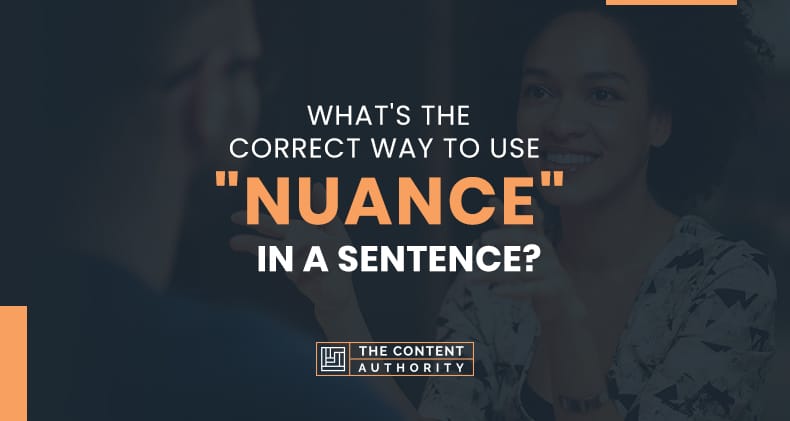One thing that we’ve probably all heard said in a conversation before is the word “nuance.” This is because it’s a popular word but one that you may not truly understand the meaning of. Knowing how to define and use this word is helpful in many circumstances today.
The word “nuance” is defined as a very small difference in the meaning, expression, or sound of something. This is why the phrase “subtle nuance” is commonly used but repetitive in nature. For instance, you may have heard that there’s a “subtle nuance” meaning there’s a “subtle difference.”
Definition of the Word “Nuance”
The word “nuance” (pronounced “NOO-ahns”) is used when you’re referring to a very small difference in something like the shade of a color, the meaning of a word, how you express yourself, or how you’re feeling. In other words, a “nuance” is a very subtle quality. So, regardless of what this difference is in, it’ll be so small that it may even be difficult to notice. Of course, there are always people who are particularly keen when it comes to noticing or being aware of these differences. These people are simply better equipped to express these things.
Some of the other words that you can use instead of “nuance” include:
- Nicety
- Refinement
- Shade
- Subtlety
- Approving
- Significance
- Signification
It’s also important to note what nuance doesn’t mean. Here are some of the antonyms for this word:
- Colorlessness
- Brighten
- Stay
- Imperfection
- Inconsequence

The Etymology of the Word “Nuance”
The word “nuance” actually comes from a French word that means “shade of color.” While the word “nuance” has been borrowed from the French in the 1780s (the 18th century) its roots can be traced back even further than that. They can be traced back to Latin where the word “nubes” meant “a cloud.” This actually makes a lot of sense because when you stop to think about clouds you’ll find yourself thinking about the subtle graduations they have in color. This thought should help you gain an even better understanding of the word “nuance.” So, for instance, when you say that a piece of artwork was “nuanced” what you’re actually saying is that there’s a lot to this piece of artwork but these things have been subtly incorporated into the artwork.
Usage of the Word “Nuance”
Sometimes we’ll spend so much time looking at something intently that eventually, the item’s minute details start to jump out at us. It doesn’t matter if we find ourselves staring at a beautiful piece of artwork here or simply staring at the same old view out the window. When you take time to look at something in this fashion you’re looking at it more analytically. By doing so you’re actually giving yourself a great gift: the gift of being able to see something in a brand new light. Even if this item seems to be quite mundane to you in the beginning, when you find these “nuances” you’ll find that the item will become all that much more interesting.
Now that you’re better able to see how this happens, it’s important to understand that this is what’s meant by “nuances.” Here the word can be defined as a key or defining aspect of an item. This aspect is very subtle – so subtle that it’ll require you to use careful discernment or analysis in order for you to be able to see it.

Another example of a “nuance” is the squirrel whom you always see in your backyard. While he probably looks like every other squirrel you’ve seen in your life when you look at the “nuances” in its fur’s pattern you’ll be able to recognize that this is indeed the squirrel who belongs in your backyard. Here what you’re actually saying is that the subtle distinctions in his fur’s markings (a.k.a. the “nuances” in his fur’s markings) make it so that this one squirrel stands out to you from all the rest of the squirrels that you see each day.
The slightest difference in a feature or a characteristic, even if you don’t need to be able to see this difference in order to understand its nature, is considered a “nuance.” For instance, you may be able to distinguish between two artists who have similar aesthetics because of the “nuances” that are present in either their color palette or the way in which their brushstrokes are shaped. However, if you don’t pause for just long enough to make these critical observations you’ll find yourself missing out on the principal aspects of each of these painters’ artwork and style. Unintentional as it may be, you’ll also miss out on the many differences that set these painters apart from one another.
Another example of a “nuance” may occur when you find yourself stopping to marvel at a typeface. While you may be interested in its curvature and the shape of its different letters you may not be able to notice enough of these things for you to be able to distinguish between this typeface and one that’s similar to it. Nevertheless, you’ll still be able to read and understand what the author means regardless of what typeface the author chooses to use. So, while you may notice the finer facets of this typeface and why the author chose to use it, this would be considered a “nuance” because these things aren’t enough for you to notice them as distinguishing characteristics. This is where the old adage rings true, with “nuances” the devil truly is in the details.
Examples of “Nuances” in Entertainment
“Nuances” don’t only occur in things like artwork and writing, you’ll also find them in the entertainment industry as well. For instance, here you might have two singers who sing a song with the exact same words, tune, and tempo but one singer may add “nuance” by adding some extra depth to the song. This is something they could do by slightly hesitating before singing a critical part of the song or singing some words louder or softer than others. When this happens you could say that the performance had been “nuanced.”
It’s important to remember that the key element in something being “nuanced” is that there’s been a subtle difference. This is something that you’d have to carefully observe in order to even notice it. You also need to remember that it’s possible that a “nuance” may only be fully appreciated or even understood if someone is either experienced or knowledgeable in the thing that’s being “nuanced.”
You’ll be able to see this throughout the entertainment because truly great actors are the ones who bring “nuance” to the lines that they speak. An example of this occurred in Ian McKellen’s rendition of Macbeth. Here in his final soliloquy “Tomorrow and tomorrow and tomorrow” McKellen brings nuance to his line. This is something that has helped to make his speech more memorable. Hopefully, it’s also something that’ll give further “nuance” to your understanding of this word.
The Difference Between Two Words: “Subtle” and “Nuance”
Now you may find yourself thinking that the word “nuance” is just another way of saying “subtle.” However, it’s important to understand that these are two completely different words with two completely different meanings. Not only is “nuance” a noun and “subtle” an adjective both there are some other differences here as well.
When you use the word “subtle” you’re trying to say that something is barely noticeable. For instance, if you say that it was a “subtle jab” what you’re saying is that it’s a jab that might have gone overlooked. However, with the word “nuance” you’re referring to something that’s more complex. For instance, a “nuanced argument” is a “complex argument. This is an example of how your choice of words is important in the English language. In this case it’s important to understand that the word “nuance” is not a synonym for the word “subtle.”

Examples of Using “Nuance” in Sentences
Hopefully, you now have a better understanding of the word “nuance.” Since it’s a bit of a tricky word to use, here are some examples of how you can use it in a sentence:
- Since she’s a chef she’s able to notice every nuance of flavor in the meal.
- We’re being slowed down by the detective’s attention to linguistic nuances.
- As a linguist, he was able to notice every nuance in her voice but quelled his expression of interest.
- I don’t want to miss any of this heathen’s nuances.
- When you look closely you’ll notice every nuance that precludes in the color of the leaves.
- He seems to enjoy gleaning every small nuance in our conversations.
- We can communicate almost every subtle nuance of emotion through our eyes.
- I wish I didn’t notice every little nuance.
Conclusion
When you use the word “nuance” you’re referring to a very small difference. This could be in regards to something’s meaning, expression, or sound. In this regard, while the phrase “subtle nuance” is commonly used it’s actually quite repetitive in nature because you’re actually saying that something is a “subtle, subtle difference.”
Shawn Manaher is the founder and CEO of The Content Authority. He’s one part content manager, one part writing ninja organizer, and two parts leader of top content creators. You don’t even want to know what he calls pancakes.

